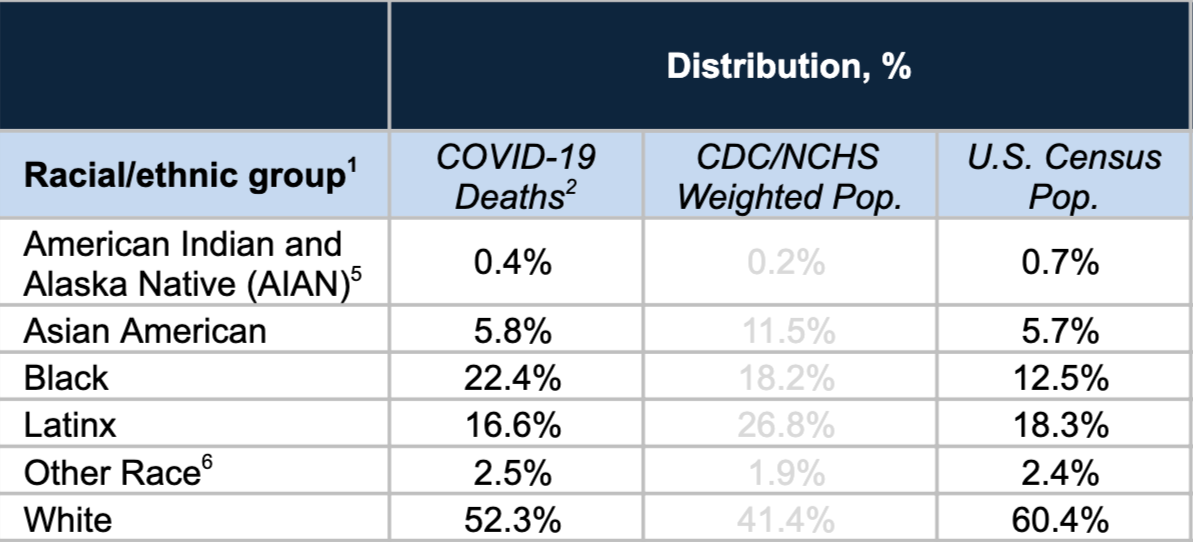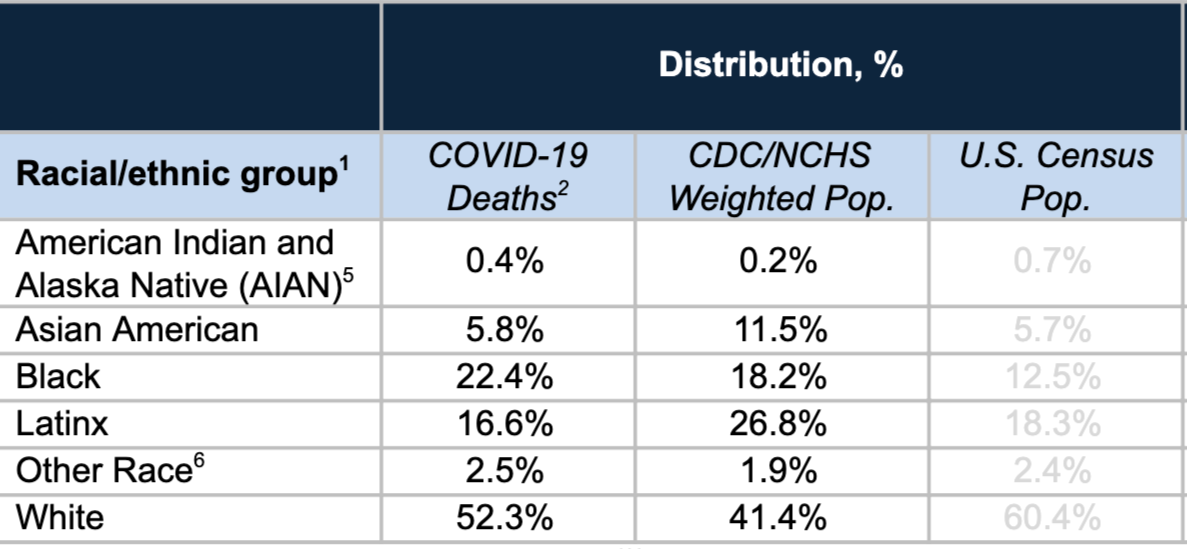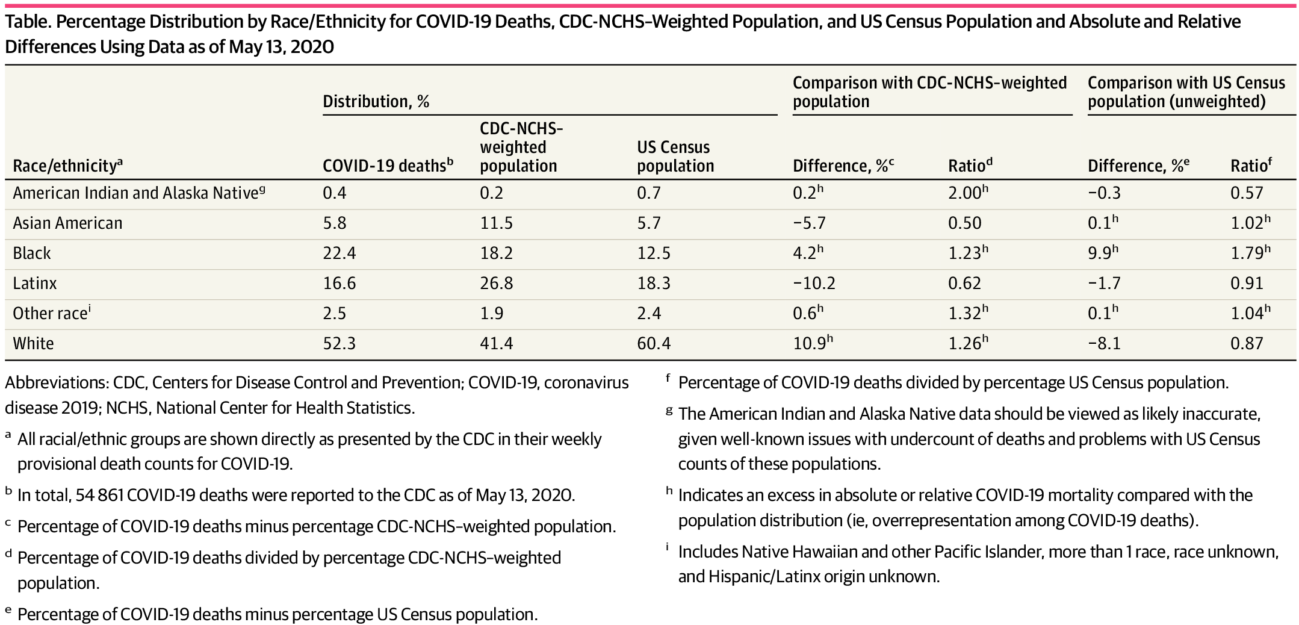A new research letter in JAMA Network Open argues that the U.S. Centers for Disease Control and Prevention (CDC) underestimates the excess burden of COVID-19 deaths among Black, Latinx, and Asian communities by comparing the percentage of U.S. COVID-19 deaths by race/ethnicity with a weighted distribution of U.S. racial/ethnic populations rather than with corresponding U.S. Census data—a distortion that has the potential to affect resource allocation. FXB Center for Health and Human Rights doctoral student cohort members Tori Cowger, Brigette Davis, Onisha Etkins, Keletso Makofane, and Jourdyn Lawrence co-authored the study with FXB Center Director and Harvard Chan Professor Dr. Mary T. Bassett and Harvard Chan Professor Dr. Nancy Krieger.
Etkins explains the importance of how public health agencies report health inequities: “These data are often used to determine how funding and resources are allocated. For example, this weighted population was used in expert witness testimony at a House Oversight Committee briefing to suggest that both Black and White individuals are over-represented in COVID-19 deaths.” She continues: “Without explicitly naming racism and structural inequities, researchers are likely to fall into the trap of reporting misleading data.”

The team analyzed publicly available aggregated data on the 54,861 COVID-19 deaths in the U.S. as of May 13. They compared the distribution of COVID-19 deaths by race/ethnicity with the CDC weighted population and with the U.S. Census unweighted population. Among their findings, “Applying the U.S. Census population distribution [see Detail 1 above from Table], Black individuals were the most over-represented among COVID-19 deaths, accounting for 9.9% greater than their share of the U.S. Census population, whereas white individuals were underrepresented (−8.1%). In contrast, comparisons with the weighted data suggest that white individuals are most over-represented among COVID-19 deaths (10.9%) [see Detail 2 below from Table].”

As the authors point out, the CDC’s rationale for the weighting is that “COVID-19 deaths are concentrated in certain geographic locations where the racial and ethnic population distribution differs from that of the United States overall.” The CDC constructs its weighting by giving greater weight to people living where there is high COVID-19 mortality, such as cities with crowded housing, many essential workers, and large populations of color and lesser weight to people living in areas with little or no mortality. This process inflates “the proportion of residents of color in the weighted population, making their risk of death appear lower, while deflating the proportion of white residents, making their risk of death appear greater.” According to the study, the CDC is presenting data on differences in death by population group, as if location does not matter. Given the importance of social and residential segregation to enforcing structural racism, Makofane points out that down-weighting people protected from COVID-19 because of the neighborhoods in which they live means that “we ignore the effect of segregation – a key mechanism of producing health inequities.”
The CDC does not report COVID-19 mortality rates by race/ethnicity. Users of the CDC data may lack context for the weighting and accept the weighted population without further inquiry. As Cowger notes, even these scholars of epidemiology found it challenging to “concisely describe the problem with how the CDC has reported COVID-19 related mortality” in regard to race and ethnicity. The goals of the research letter were to “clarify the methodology that CDC is using to construct their weighted population and to critically describe why we think this approach is problematic.”
Davis expands further on the researchers’ aims: “We hope this research will dissuade independent researchers, particularly in the public sphere, from using the CDC’s re-weighted population when studying COVID-19-related health inequities. More broadly, we hope it will encourage critical thinking on the structural mechanisms that lead to racial health inequities related to COVID. Examining the influence of racism on outcomes, instead of race, is imperative to addressing these injustices.”
Lawrence elaborates on what drew the doctoral candidates to this project: “Racial disparities do not occur by chance. Helping to ensure that the public has accurate information about inequities is a first step to working together to eliminate them. The weighting method implemented by the CDC attempts to compare COVID-19 mortalities without considering the discriminatory policies and practices that have led to the residential distribution of Black, Latinx, Asian, and Native American communities.”
The research letter concludes with a call for the CDC “to drop the misleading weighted counts and publish mortality rates per race/ethnicity group stratified by age, gender, education, and ZIP code characteristics1 to adequately equip epidemiologists and policy makers with the data to mitigate inequities.”
The faculty authors Dr. Bassett and Professor Krieger have each dedicated their careers to investigating health inequities and have highlighted the importance of good data to creating and measuring change. They have previously collaborated on several papers on the subject. The enthusiasm and passion of the next generation of public health scholars inspires them both.
For the doctoral candidates, this research has reinforced the importance of their scholarly paths. In Makofane’s words, “What seem like obscure epidemiological methods make a difference in how inequity is quantified and redressed.”
To read the article, click here.

“Comparison of Weighted and Unweighted Population Data to Assess Inequities in Coronavirus-2019 Deaths by Race/Ethnicity” Authors, from left: Cowger, Davis, Etkins, Makofane, Lawrence, Bassett, Krieger

